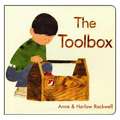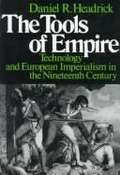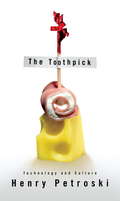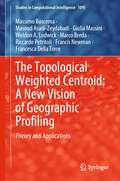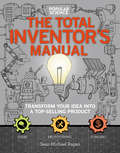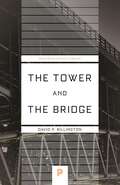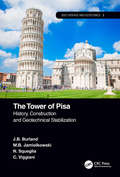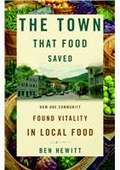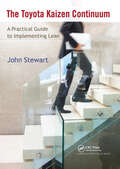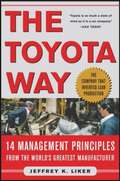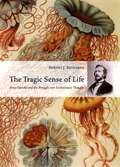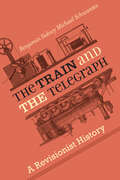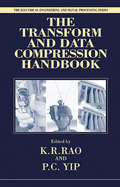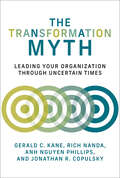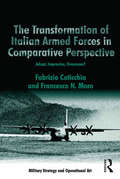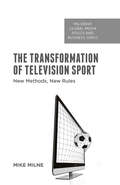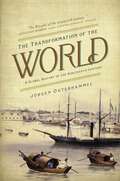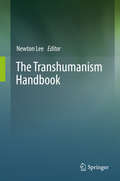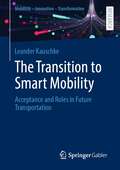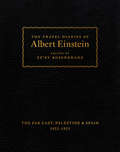- Table View
- List View
The Toolbox
by Anne F. Rockwell Harlow RockwellLook inside this well-loved toolbox-there is so much to discover! It holds strong wrenches that turn, pliers that pinch, and sandpaper that smooths. There are nails, screws, and a hammer. A toolbox is a treasure trove for curious young builders.
The Tools of Empire: Technology and European Imperialism in the Nineteenth Century
by Daniel R. HeadrickExcellent for global history courses because of its focus on Asia and Africa during the critical period of European imperialism.
The Toothpick
by Henry PetroskiA celebration culture and technology, as seen through the history of the humble yet ubiquitous toothpick, from the best-selling author of The Pencil.From ancient Rome, where emperor Nero made his entrance into a banquet hall with a silver toothpick in his mouth, to nineteenth-century Boston, where Charles Forster, the father of the American wooden toothpick industry, ensured toothpicks appeared in every restaurant, the toothpick has been an omnipresent, yet often overlooked part of our daily lives. Here, with an engineer's eye for detail and a poet's flair for language, Henry Petroski takes us on an incredible tour of this most interesting invention. Along the way, he peers inside today's surprisingly secretive toothpick-manufacturing industry, and explores a treasure trove of the toothpick's unintended uses and perils, from sandwiches to martinis and beyond.From the Trade Paperback edition.
The Toothpick
by Henry PetroskiA celebration culture and technology, as seen through the history of the humble yet ubiquitous toothpick, from the best-selling author of The Pencil.From ancient Rome, where emperor Nero made his entrance into a banquet hall with a silver toothpick in his mouth, to nineteenth-century Boston, where Charles Forster, the father of the American wooden toothpick industry, ensured toothpicks appeared in every restaurant, the toothpick has been an omnipresent, yet often overlooked part of our daily lives. Here, with an engineer's eye for detail and a poet's flair for language, Henry Petroski takes us on an incredible tour of this most interesting invention. Along the way, he peers inside today's surprisingly secretive toothpick-manufacturing industry, and explores a treasure trove of the toothpick's unintended uses and perils, from sandwiches to martinis and beyond.From the Trade Paperback edition.
The Toothpick: Technology and Culture
by Henry PetroskiLike The Pencil, Henry Petroski's The Toothpick is a celebration of a humble yet elegant device. As old as mankind and as universal as eating, this useful and ubiquitous tool finally gets its due in this wide-ranging and compulsively readable book. Here is the unexpected story of the simplest of implements--whether made of grass, gold, quill, or wood--a story of engineering and design, of culture and class, and a lesson in how to discover the extraordinary in the ordinary. Petroski takes us back to ancient Rome, where the emperor Nero makes his entrance into a banquet hall with a silver toothpick in his mouth; and to a more recent time in Spain, where a young señorita uses the delicately pointed instrument to protect her virtue from someone trying to steal a kiss. He introduces us to Charles Forster, a nineteenth-century Bostonian and father of the American toothpick industry, who hires Harvard students to demand toothpicks in area restaurants--thereby making their availability in eating establishments as expected as condiments. And Petroski takes us inside the surprisingly secretive toothpick-manufacturing industry, in which one small town's factories can turn out 200 million wooden toothpicks a day using methods that, except for computer controls, haven't changed much in almost 150 years. He also explores a treasure trove of the toothpick's unintended uses and perils, from sandwiches to martinis and beyond. With an engineer's eye for detail and a poet's flair for language, Petroski has earned his reputation as a writer who explains our world--from the tallest buildings to the lowliest toothpick--to us.
The Topological Weighted Centroid: Theory and Applications (Studies in Computational Intelligence #1095)
by Massimo Buscema Weldon A. Lodwick Giulia Massini Marco Breda Francis Newman Masoud Asadi-Zeydabadi Riccardo Petritoli Francesca Della TorreThis book introduces the Topological Weighed Centroid approach and describes some applications in the study of the dynamics of various spatial phenomena with a special emphasis on the spatial analysis of the relationship, influence, and dynamics of geographical phenomena. Offering a comprehensive introduction to the theory and illustrative examples from various kinds of geographical data, this book also takes an in-depth look at more complex case studies, such as the applications of the topological weighed centroid approach in the study of epidemic patterns, cultural processes, criminality, and environmental phenomena.
The Tornado Scientist: Seeing Inside Severe Storms (Scientists in the Field Series)
by Mary Kay CarsonIn this addition to the critically-acclaimed Scientist in the Field series, scientist Robin Tanamachi and her team are trying to save countless lives across America’s heartland, chasing one tornado at a time. Robin Tanamachi has been captivated by tornadoes and extreme weather her entire life. When she realized people researched weather for a job, she was hooked. She now studies tornadogenesis, or how tornadoes form, and what causes them to get weaker versus strengthen. For her, driving around in a Doppler radar truck aiming towards storms is a normal day in the office. The data she collects is then modeled and studied on computers—with math, physics, and computer science working hand in hand with meteorology. At the end of the day, knowing exactly how, when, and where these violent storms happen can give more warning time for everyone involved.
The Total Inventor's Manual: Transform Your Idea into a Top-Selling Product (Popular Science)
by Sean Michael RaganThis comprehensive guide from the editors of Popular Science covers everything a new inventor needs to know from starting out to running a start-up. Contrary to popular opinion, you don&’t have to be an ace electrician or a coding prodigy to develop your own game-changing invention. All you need is curiosity, a desire to fix a common problem, and the determination to see your ideas become reality. And it won&’t hurt to have this book handy—a volume full of vital tips, skills, and strategies that will take you from zero to inventor. Everyone knows about Bill Gates or Steve Jobs, but in TheTotal Inventor&’s Manual, you&’ll also learn from the examples of those intrepid inventors who gave us the first home pregnancy test, the Super Soaker, the Roomba, the digital camera, and many other products that have changed the world. Here you will learn to turn your vision into a reality with a crash course in ideation, prototyping, and testing—including lessons in 3D-printing, coding, robotics, and more. You&’ll discover funding strategies that range from running a Kickstarter campaign to making a venture capital pitch, plus tips on manufacturing, supply chains, marketing, and running—or selling—your new company!
The Tower and the Bridge: The New Art of Structural Engineering (Princeton Science Library #130)
by David P. BillingtonAn essential exploration of the engineering aesthetics of celebrated structures from long-span bridges to high-rise buildingsWhat do structures such as the Eiffel Tower, the Brooklyn Bridge, and the concrete roofs of Pier Luigi Nervi have in common? According to The Tower and the Bridge, all are striking examples of structural art, an exciting area distinct from either architecture or machine design. Aided by stunning photographs, David Billington discusses the technical concerns and artistic principles underpinning the well-known projects of leading structural engineer-artists, including Othmar Ammann, Félix Candela, Gustave Eiffel, Fazlur Khan, Robert Maillart, John Roebling, and many others. A classic work, The Tower and the Bridge introduces readers to the fundamental aesthetics of engineering.
The Tower of Pisa: History, Construction and Geotechnical Stabilization (Built Heritage and Geotechnics)
by J.B. Burland M.B. Jamiolkowski N. Squeglia C. ViggianiThe Leaning Tower of Pisa is known worldwide for its five-degree lean. The Tower is the Campanile of the Cathedral, which together with the Baptistry and Cemetery form a breath-taking collection of monuments which are regarded as supreme examples of early Renaissance Romanesque architecture. In March 1990 the Tower was closed to the public as it was declared unsafe and close to collapse. A Commission was set up by the Italian Government with the task of developing and implementing stabilization measures. This book begins with a brief description of the history of the Tower and its construction. The reader is then introduced to the huge challenges faced by the Commission in designing and implementing appropriate stabilization measures whilst at the same time satisfying the demanding requirements of conserving a world heritage monument. In particular, two historical studies are described which proved to be most valuable in arriving at suitable stabilization measures. The first was a deduction of the history of inclination of the tower during and subsequent to construction. The results of this study were used to calibrate a sophisticated numerical model of the tower and the underlying very soft ground which proved vital in evaluating the effectiveness of various stabilization schemes. The second study was of measurements of movement made since 1911. This latter study revealed an unexpected mechanism of foundation movement which proved crucial in developing the temporary and permanent stabilization measures and which resulted in the Tower being re-opened to the public in June 2001. The book will appeal to both professionals and students in the fields of Architecture and Civil Engineering. It will also interest specialised audiences of geotechnical engineers and conservation architects. It may also be of wider interest to anyone planning to visit Pisa or who is intrigued as to what caused the Tower to lean and how it was stabilized.
The Town That Food Saved: How One Community Found Vitality in Local Food
by Ben HewittOver the past 3 years, Hardwick, Vermont, a typical hardscrabble farming community of 3,000 residents, has jump-started its economy and redefined its self-image through a local, self-sustaining food system unlike anything else in America. Even as the recent financial downturn threatens to cripple small businesses and privately owned farms, a stunning number of food-based businesses have grown in the region-Vermont Soy, Jasper Hill Farm, Pete's Greens, Patchwork Farm & Bakery, Apple Cheek Farm, Claire's Restaurant and Bar, and Bonnieview Farm, to name only a few. The mostly young entrepreneurs have created a network of community support; they meet regularly to share advice, equipment, and business plans, and to loan each other capital. Hardwick is fast becoming a model for other communities to replicate its success. Author Ben Hewitt presents the captivating story of a small town coming back to life,The Town That Food Savedis narrative nonfiction at its best: full of colorful characters and grounded in an idea that will revolutionize the way we eat.
The Toyota Kaizen Continuum: A Practical Guide to Implementing Lean
by John StewartWritten by a recognized leader in the manufacturing industry with nearly two decades of experience working for Toyota, this book supplies a firsthand account of the realities behind implementing the Toyota Production System (TPS). The Toyota Kaizen Continuum: A Practical Guide to Implementing Lean presents authoritative insight on how to use the TPS to drive operational value and improvement across all segments of an organization.Highlighting valuable lessons learned directly from the TPS masters at the Toyota factories in Japan, John Stewart provides a time-tested approach for implementing a process of continuous improvement. Delving into his wide-ranging experience that includes time as a team member on the assembly line and managing the vehicle assembly division for Toyota`s largest European operation in the United Kingdom he explains how to get the process started, how to get senior management excited about the possibilities, and details a process for implementing the TPS in your organization. Written by an industry veteran named one of the Top 10 Automotive Executives by Automotive News in 2007 Unveils the methods used within the walls of the worlds premier manufacturing organization Illustrates valuable lessons learned with real-world examples of TPS implementations Describes five simple steps for executing change in any organization The book includes case studies that illustrate real-life successes and failures behind the walls of the worlds largest automobile manufacturing organization. Detailing a five-step process for executing improvement initiatives, it supplies you with the tools and understanding of the core principles of the TPS needed to implement and sustain a culture of continuous improvement in your organization.
The Toyota Way: 14 Management Principles from the World's Greatest Manufacturer
by Jeffrey K. LikerHow to speed up business processes, improve quality, and cut costs in any industry in factories around the world. Toyota consistently makes the highest-quality cars with the fewest defects of any competing manufacturer, while using fewer man-hours, less on-hand inventory, and half the floor space of its competitors. The Toyota Way is the first book for a general audience that explains the management principles and business philosophy behind Toyota's worldwide reputation for quality and reliability. Complete with profiles of organizations that have successfully adopted Toyota's principles, this book shows managers in every industry how to improve business processes by: Eliminating wasted time and resources, Building quality into workplace systems, Finding low-cost but reliable alternatives to expensive new technology, Producing in small quantities, and Turning every employee into a quality control inspector.
The Tragic Sense of Life: Ernst Haeckel and the Struggle over Evolutionary Thought
by Robert J. RichardsA biography of the controversial German evolutionist Ernst Haeckel (1834-1919)
The Tragic Sense of Life: Ernst Haeckel and the Struggle over Evolutionary Thought
by Robert J. RichardsPrior to the First World War, more people learned of evolutionary theory from the voluminous writings of Charles Darwin’s foremost champion in Germany, Ernst Haeckel (1834–1919), than from any other source, including the writings of Darwin himself. But, with detractors ranging from paleontologist Stephen Jay Gould to modern-day creationists and advocates of intelligent design, Haeckel is better known as a divisive figure than as a pioneering biologist. Robert J. Richards’s intellectual biography rehabilitates Haeckel, providing the most accurate measure of his science and art yet written, as well as a moving account of Haeckel’s eventful life.
The Train and the Telegraph: A Revisionist History (Hagley Library Studies in Business, Technology, and Politics)
by Benjamin Sidney SchwantesA challenge to the long-held notion of close ties between the railroad and telegraph industries of the nineteenth century.To many people in the nineteenth century, the railroad and the telegraph were powerful, transformative forces, ones that seemed to work closely together to shape the economy, society, and politics of the United States. However, the perception—both popular and scholarly—of the intrinsic connections between these two institutions has largely obscured a far more complex and contested relationship, one that created profound divisions between entrepreneurial telegraph promoters and warier railroad managers. In The Train and the Telegraph, Benjamin Sidney Michael Schwantes argues that uncertainty, mutual suspicion, and cautious experimentation more aptly describe how railroad officials and telegraph entrepreneurs hesitantly established a business and technical relationship. The two industries, Schwantes reveals, were drawn together gradually through external factors such as war, state and federal safety regulations, and financial necessity, rather than because of any perception that the two industries were naturally related or beneficial to each other. Complicating the existing scholarship by demonstrating that the railroad and telegraph in the United States were uneasy partners at best—and more often outright antagonists—throughout the nineteenth and early twentieth centuries, The Train and the Telegraph will appeal to scholars of communication, transportation, and American business history and political economy, as well as to enthusiasts of the nineteenth-century American railroad industry.
The Transform and Data Compression Handbook (Electrical Engineering & Applied Signal Processing Series)
by K. R. Rao P. C. YipData compression is one of the main contributing factors in the explosive growth in information technology. Without it, a number of consumer and commercial products, such as DVD, videophone, digital camera, MP3, video-streaming and wireless PCS, would have been virtually impossible. Transforming the data to a frequency or other domain enables even more efficient compression. By illustrating this intimate link, The Transform and Data Compression Handbook serves as a much-needed handbook for a wide range of researchers and engineers.The authors describe various discrete transforms and their applications in different disciplines. They cover techniques, such as adaptive quantization and entropy coding, that result in significant reduction in bit rates when applied to the transform coefficients. With clear and concise presentations of the ideas and concepts, as well as detailed descriptions of the algorithms, the authors provide important insight into the applications and their limitations. Data compression is an essential step towards the efficient storage and transmission of information. The Transform and Data Compression Handbook provides a wealth of information regarding different discrete transforms and demonstrates their power and practicality in data compression.
The Transformation Myth: Leading Your Organization through Uncertain Times (Management on the Cutting Edge)
by Gerald C. Kane Anh Nguyen Phillips Jonathan R. Copulsky Rich NandaHow companies can adapt in an era of continuous disruption: a guide to responding to such acute crises as COVID-19.When COVID-19 hit, businesses had to respond almost instantaneously--shifting employees to remote work, repairing broken supply chains, keeping pace with dramatically fluctuating customer demand. They were forced to adapt to a confluence of multiple disruptions inextricably linked to a longer-term, ongoing digital disruption. This book shows that companies that use disruption as an opportunity for innovation emerge from it stronger. Companies that merely attempt to "weather the storm" until things go back to normal (or the next normal), on the other hand, miss an opportunity to thrive. The authors, all experts on business and technology strategy, show that transformation is not a one-and-done event, but a continuous process of adapting to a volatile and uncertain environment. Drawing on five years of research into digital disruption--including a series of interviews with business leaders conducted during the COVID-19 crisis--they offer a framework for understanding disruption and tools for navigating it. They outline the leadership traits, business principles, technological infrastructure, and organizational building blocks essential for adapting to disruption, with examples from real-world organizations. Technology, they remind readers, is not an end in itself, but enables the capabilities essential for surviving an uncertain future: nimbleness, scalability, stability, and optionality.
The Transformation of Italian Armed Forces in Comparative Perspective: Adapt, Improvise, Overcome? (Military Strategy and Operational Art)
by Fabrizio Coticchia Francesco N. MoroEuropean armed forces have undergone deep changes in the past two decades. Given the breadth of the debate and the size of transformations that took place, it is somewhat surprising that relatively few academic studies have directly dealt with changes in force structure of European militaries, and the Italian armed forces in particular. The focus of this book is the organizational dimension of the restructuring of armed forces through 3 different lenses: doctrine and strategic framework, budget and resource allocation, and force structure and deployment. The key issues addressed relate to how these factors interact in shaping transformation. Of particular interest is the theme of learning, which is how armed forces endogenize change in the short and long run. This study provides valuable insights into the extent to which armed forces manage to adapt to the emerging strategic and operational challenges they have to face and to illustrate the weight of institutional legacies, resource constraints and inter-organizational learning in shaping transformation. Focusing on the Italian case in comparative perspective and based on a large variety of military operations from airstrikes to peacekeeping and counterinsurgency, the book provides an innovative viewpoint on military transformation and significantly contributes to our understanding of contemporary security that is deeply shaped by the lessons learnt in Afghanistan, Lebanon, Iraq and Libya.
The Transformation of Television Sport: New Methods, New Rules (Palgrave Global Media Policy and Business)
by M. MilneThe Transformation of Television Sport: New Methods, New Rules examines how developments in technology, broadcasting rights and regulation combine to determine what sport we see on television, where we can see it and what the final output looks and sounds like.
The Transformation of the World: A Global History of the Nineteenth Century (America in the World #20)
by Jürgen OsterhammelA panoramic global history of the nineteenth centuryA monumental history of the nineteenth century, The Transformation of the World offers a panoramic and multifaceted portrait of a world in transition. Jürgen Osterhammel, an eminent scholar who has been called the Braudel of the nineteenth century, moves beyond conventional Eurocentric and chronological accounts of the era, presenting instead a truly global history of breathtaking scope and towering erudition. He examines the powerful and complex forces that drove global change during the "long nineteenth century," taking readers from New York to New Delhi, from the Latin American revolutions to the Taiping Rebellion, from the perils and promise of Europe's transatlantic labor markets to the hardships endured by nomadic, tribal peoples across the planet. Osterhammel describes a world increasingly networked by the telegraph, the steamship, and the railways. He explores the changing relationship between human beings and nature, looks at the importance of cities, explains the role slavery and its abolition played in the emergence of new nations, challenges the widely held belief that the nineteenth century witnessed the triumph of the nation-state, and much more.This is the highly anticipated English edition of the spectacularly successful and critically acclaimed German book, which is also being translated into Chinese, Polish, Russian, and French. Indispensable for any historian, The Transformation of the World sheds important new light on this momentous epoch, showing how the nineteenth century paved the way for the global catastrophes of the twentieth century, yet how it also gave rise to pacifism, liberalism, the trade union, and a host of other crucial developments.
The Transhumanism Handbook
by Newton LeeModern humanity with some 5,000 years of recorded history has been experiencing growing pains, with no end in sight. It is high time for humanity to grow up and to transcend itself by embracing transhumanism. Transhumanism offers the most inclusive ideology for all ethnicities and races, the religious and the atheists, conservatives and liberals, the young and the old regardless of socioeconomic status, gender identity, or any other individual qualities. This book expounds on contemporary views and practical advice from more than 70 transhumanists. Astronaut Neil Armstrong said on the Apollo 11 moon landing in 1969, “One small step for a man, one giant leap for mankind.” Transhumanism is the next logical step in the evolution of humankind, and it is the existential solution to the long-term survival of the human race.
The Transition Handbook
by Rob HopkinsWe live in an oil-dependent world, arriving at this level of dependency in a very short space of time by treating petroleum as if it were in infinite supply. Most of us avoid thinking about what happens when oil runs out (or becomes prohibitively expensive), but The Transition Handbook shows how the inevitable and profound changes ahead can have a positive outcome. These changes can lead to the rebirth of local communities that will grow more of their own food, generate their own power, and build their own houses using local materials. They can also encourage the development of local currencies to keep money in the local area. There are now over 30 "transition towns" in the UK, Australia and New Zealand with more joining as the idea takes off. They provide valuable experience and lessons-learned for those of us on this side of the Atlantic. With little proactive thinking at the governmental level, communities are taking matters into their own hands and acting locally. If your town is not a transition town, this upbeat guide offers you the tools for starting the process.
The Transition to Smart Mobility: Acceptance and Roles in Future Transportation (Mobilität – Innovation – Transformation)
by Leander KauschkeMost contemporary notions of the fairly recent concept ‘smart mobility’ portray an imminent transition of similar socio-economic consequences as the shift from horses to automobiles did 100 years ago. Present book thus offers an in-depth look at the variables involved in the equation of smart mobility acceptance (1) and envisaged institutional change (2).Both views are embedded in the Multi-Level Perspective. Study 1 develops a structural equation model in SmartPLS. Use cases cover eBikes (N=537), mobility-as-a-service (N=531), and fully automated vehicles (N=558). Based on the results, acceptance relies on five factors: performance expectancy, facilitating conditions, social influence, habit, and hedonic motivation.Study 2 applies the Institutional Role Model (IRM) to better understand system dynamics. Thus, the smart mobility ecosystem is mapped in a structured manner. It identifies nine institutions, as well as four technical and four economic roles. Results of interviews with experts (N=8) support the IRM’s significance as a vision provider for a new mobility regime.In the end, these two perspectives amalgamate. This opens a sophisticated space for public debate about the commencing transition to smart mobility.
The Travel Diaries of Albert Einstein: The Far East, Palestine, and Spain, 1922 - 1923
by Albert Einstein Ze'Ev RosenkranzThe first publication of Albert Einstein’s travel diary to the Far East and Middle EastIn the fall of 1922, Albert Einstein, along with his then-wife, Elsa Einstein, embarked on a five-and-a-half-month voyage to the Far East and Middle East, regions that the renowned physicist had never visited before. Einstein's lengthy itinerary consisted of stops in Hong Kong and Singapore, two brief stays in China, a six-week whirlwind lecture tour of Japan, a twelve-day tour of Palestine, and a three-week visit to Spain. This handsome edition makes available, for the first time, the complete journal that Einstein kept on this momentous journey. The telegraphic-style diary entries--quirky, succinct, and at times irreverent—record Einstein's musings on science, philosophy, art, and politics, as well as his immediate impressions and broader thoughts on such events as his inaugural lecture at the future site of the Hebrew University in Jerusalem, a garden party hosted by the Japanese Empress, an audience with the King of Spain, and meetings with other prominent colleagues and statesmen. Entries also contain passages that reveal Einstein's stereotyping of members of various nations and raise questions about his attitudes on race. This beautiful edition features stunning facsimiles of the diary's pages, accompanied by an English translation, an extensive historical introduction, numerous illustrations, and annotations. Supplementary materials include letters, postcards, speeches, and articles, a map of the voyage, a chronology, a bibliography, and an index. Einstein would go on to keep a journal for all succeeding trips abroad, and this first volume of his travel diaries offers an initial, intimate glimpse into a brilliant mind encountering the great, wide world.
